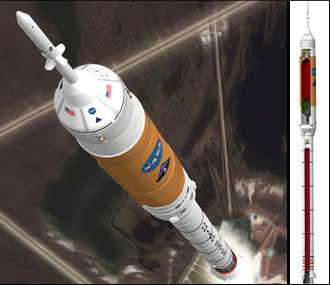The system requirements review confirms that the previous stages of the design - the system requirements stages, have been completed, verified and are in line with the mission requirements. The review also confirms that the Ares 1 architecture and design concept can fulfill the mission objectives and that the Ares project is ready for the engineering design phase

Left: A concept image of the Ares 1 rocket, the launch vehicle that will carry the Orion capsules and 4-6 crew members into orbit around the Earth. Image: NASA/MSFC Right: Concept image of the missile, after two evaluation cycles
Huntsville, Alabama. NASA has completed a review examining the requirements for the Ares 1 launch vehicle (Ares I) that will be used to launch the Orion model manned spacecraft. NASA describes this step as a milestone in the field of aircraft belonging to the manned space program for 30 years. The review advances the space agency a step forward towards the development of the new generation of space travel systems for astronauts on flights to the moon, Mars and other destinations.
"This is a crucial step in the development of the Ares 1 launcher," said Constellation Program Manager Jeff Henley. "We invested a lot in engineering analyzes and designs to write a review that would give us confidence to continue the design work of Ares 1."
The system requirements review confirms that the previous stages of the design - the system requirements stages, have been completed, verified and are in line with the mission requirements. The review also confirms that Ares 1's architecture and design concept can fulfill mission objectives and that the Ares project is ready for the engineering design phase. An initial review of these stages is planned for mid-2008.
This review is the first in a series of milestones that NASA is required to stumble upon before building the first rocket. Each such review provides more detailed requirements for the vehicle design to ensure that the overall system meets all NASA reliability and flight safety requirements. The review process will also identify technical and managerial challenges, and identify ways to mitigate potential hazards as the project progresses.
"The successful completion of the first in the series of reviews is the result of a lot of hard work and many hours by many people all over the US in both government and industry," says Steve Cook, director of the Exploration Launch Office at the Marshall Center. "The result of their efforts is board approval that we have a good and solid set of requirements for the initiation phase of Ares 1 design."
Among the details that were addressed in the review was the commitment to meet the reduction of operating costs through streamlining and simplifying the launcher's production process. All hardware components - the first stage, the upper stage and the engine of the upper stage - will be easy to operate to allow NASA to maintain a long-term presence in space without exceeding the budget.
The current review was written after successful systemic reviews of the project's components, including the J-2X engine, the Ares-1 first stage, and the test flight design. The J-2X engine will be the one that will power the Ares 1 upper stage, and will also serve as the Earth orbit departure engine for the Ares 5 spacecraft, which will propel Orion from Earth orbit to lunar orbit. The Ares I-1 unmanned test flight is planned for 2009, and will be the first test flight in which all launcher systems are integrated.
In January 2007, Project Ares will begin the second cycle in the series of design analyzes to update the launcher design. This cycle will be the baseline planning that brings together all the changes made within the first cycle. In the updated Ares 1 configuration, the bulkhead in the upper stage between the liquid hydrogen and liquid oxygen tanks is in an intermediate tank, which shortens the launcher. The thrust profile of the Ares 1 first stage also became a baseline. This means that the requirements have already been finalized as to how the five solid fuel boosters will be ignited during liftoff.
The Constellation program, headquartered in Houston, bears overall responsibility for the development of the passenger spacecraft and their launchers that are supposed to support NASA's manned program designed to expand the human presence in the solar system. The office responsible for the launcher project is located at the NASA Space Center in Huntsville, Alabama, and is responsible for the design and development of the Ares 1 and Ares 5 launchers. The Johnson Space Center in Houston is also responsible for developing the Orion capsule and operating the mission. NASA's Kennedy Space Center in Florida is responsible for operations on the ground and during launch. The program also includes many project teams at all NASA centers and at subcontractors across the US.
